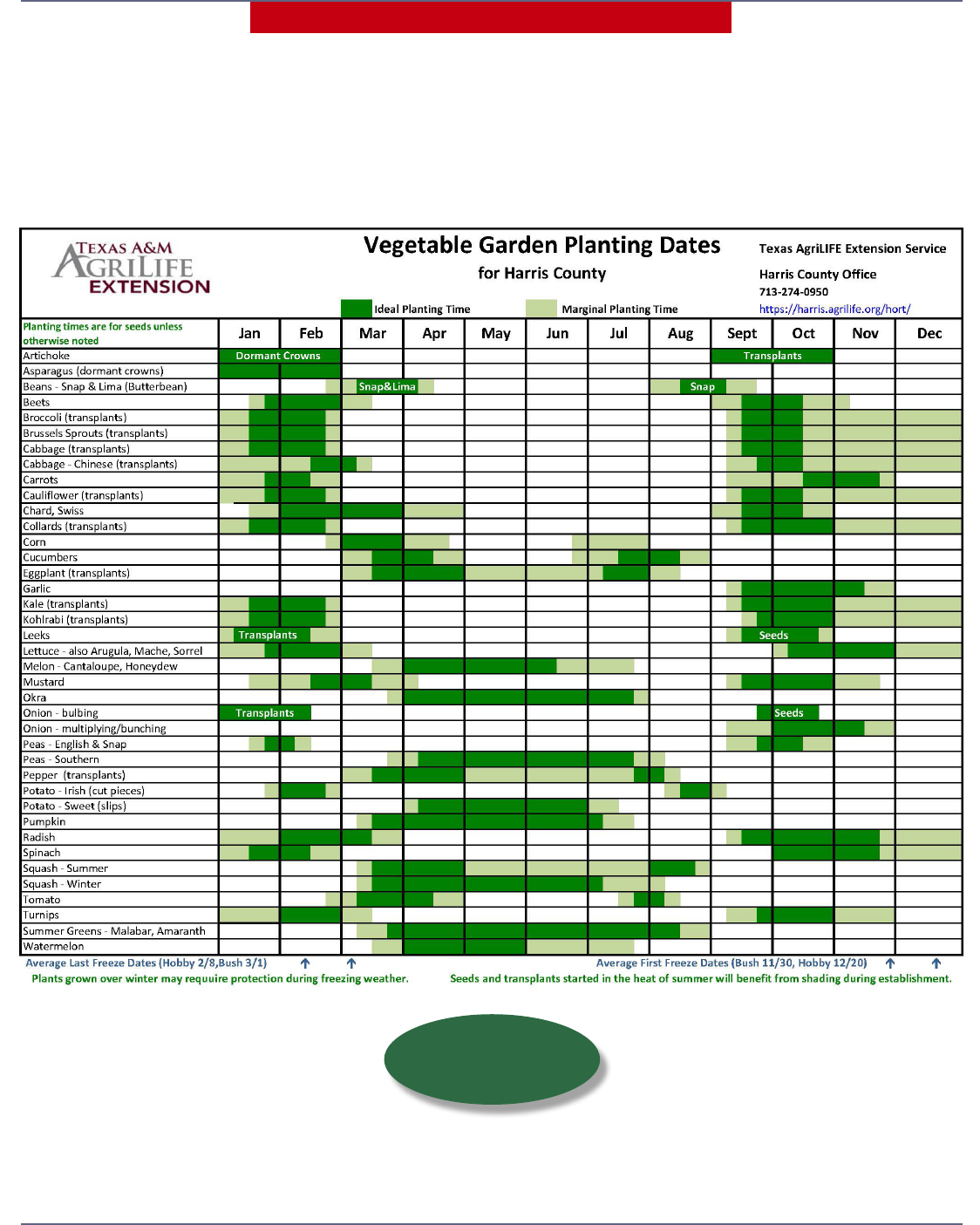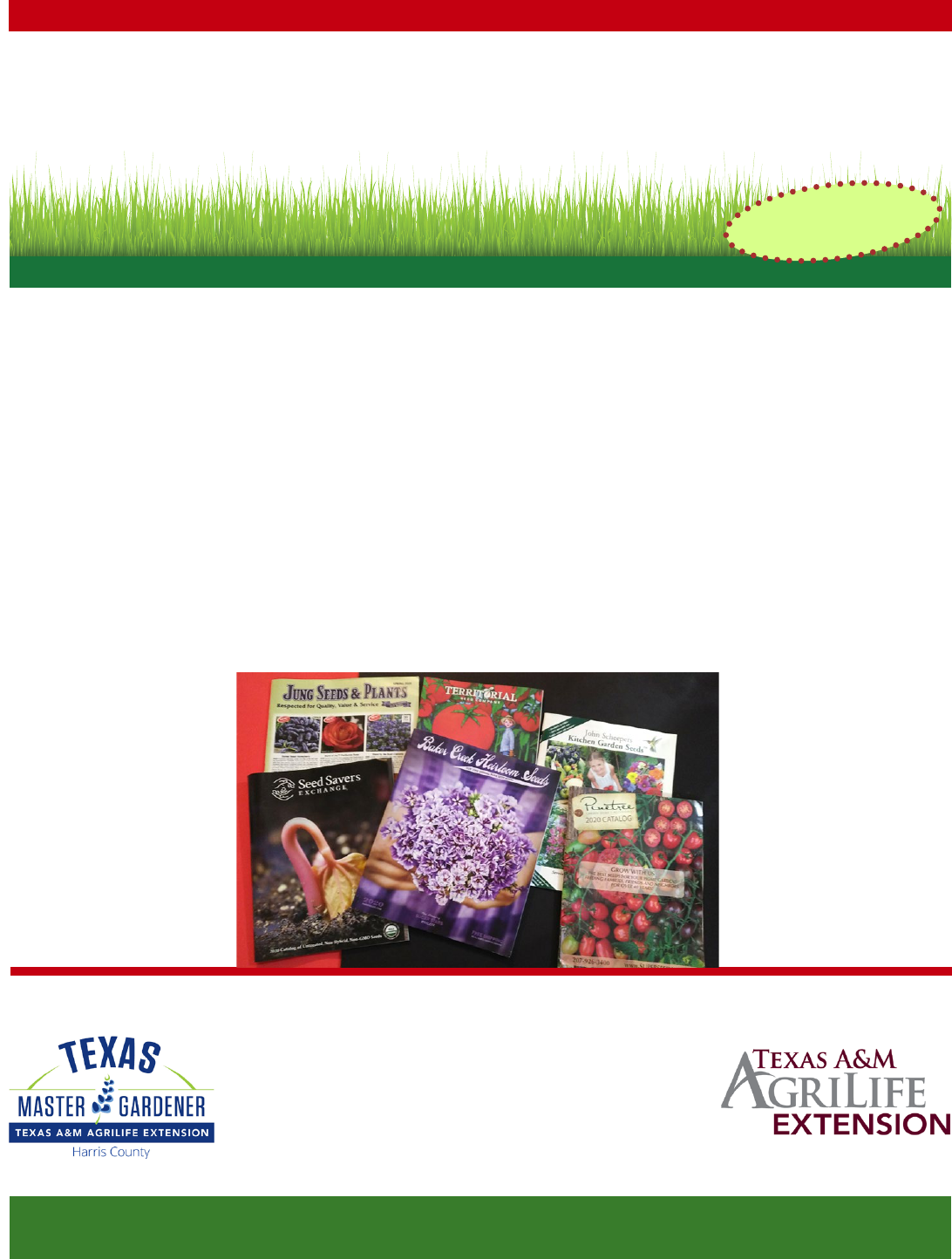
HARRIS COUNTY MASTER GARDENER NEWSLETTER • FEBRUARY 2020
Urban Di
Gardening Events and Information for Texans
One by one my lovelies have been arriving for at least a month
now and I am ready. The seed catalogs are here. Part of my spring
fever is because it’s an annual occurrence for me at this time of the
year, but this recent weather has me itching to see seedlings break-
ing through the earth. On January 15th and 16th of this year we
had unusual weather. I have lived within this area for my entire life
and not once do I recall turning on my air conditioning in January,
but I did. Depending on your weather source on those two days our
high ranged from 79-81°. No wonder our plants are so confused.
I had amaryllis bloom out of season, my neighbor’s peach trees
started owering in December and her bewildered grapevine tried
to put forth tiny tendrils with
grapes. What a dilemma.
My security blanket is
seedlings. I am still new to seed
propagation. How I wish I could
channel Louis Mickler, our Ge-
noa Friendship Garden’s seed-
ling pro. Louis fears no seed
or cutting and he loves plant
propagation. My mind is racing
Preparing for Spring
back and forth trying to decide what to plant. My rst true love is
herbs, primarily basil, but I am also branching out into other areas.
My garlic has been in the ground since the end of September and
the temperature uctuations do not seem to have affected it. In my
refrigerator I have Aralia spinosa seeds nestled into egg cartons
and today I will drag out my heat mat and begin planting my pep-
per seeds. Soon to follow will be other seeds I have ordered. The
leaf or cutting celery, the lemon grass seeds and the burdock root
seeds are patiently waiting their turn. Special growing boxes are
recommended for the burdock root so that’s another project. I feel
as though I am being pulled in so many directions but I love it.
With this intemperate
weather, seeds or transplants
are the best way to go with
vegetable gardens. Most of us
do that way anyway since the
majority of vegetables are annu-
als. Make your beds! Remember
when your mom told you that
growing up? Did you realize
back then you would grow up
and continually do that inside
by Terri Simon, Master Gardener
cont'd on pg. 8
Upcoming Events ......................... 2
President's Perspective .................. 3
Herb of the Month ........................4
Plant of the Month .......................5
2020 Plant Sale Dates! ..................7
MG Award Luncheon ....................9
Ask a Master Gardener ...............10
Master Gardeners in the City ..... 11
Growing with Plants & Nature ..12
Landscaping with Vegetables .....13
The Rose Corner .........................14
Open Garden Days at Genoa
Friendship Gardens ................15
GFG Greenhouse Rehab Update ..16
Scenes from the West Side Sale . 17
Master Gardener of the Month ...18
Master Gardener Birthdays .........18
TMGA 2020 State Conference ...19
Gardening Tools ......................... 20
Have Garden Questions?
Email your questions and photos to: phone [email protected] or
Call us Monday – Friday 9:00 am to Noon at 713-274-0950
Spring Vegetable
Gardening
Terri's favorite seed catalogs
Photo by Terri Simon
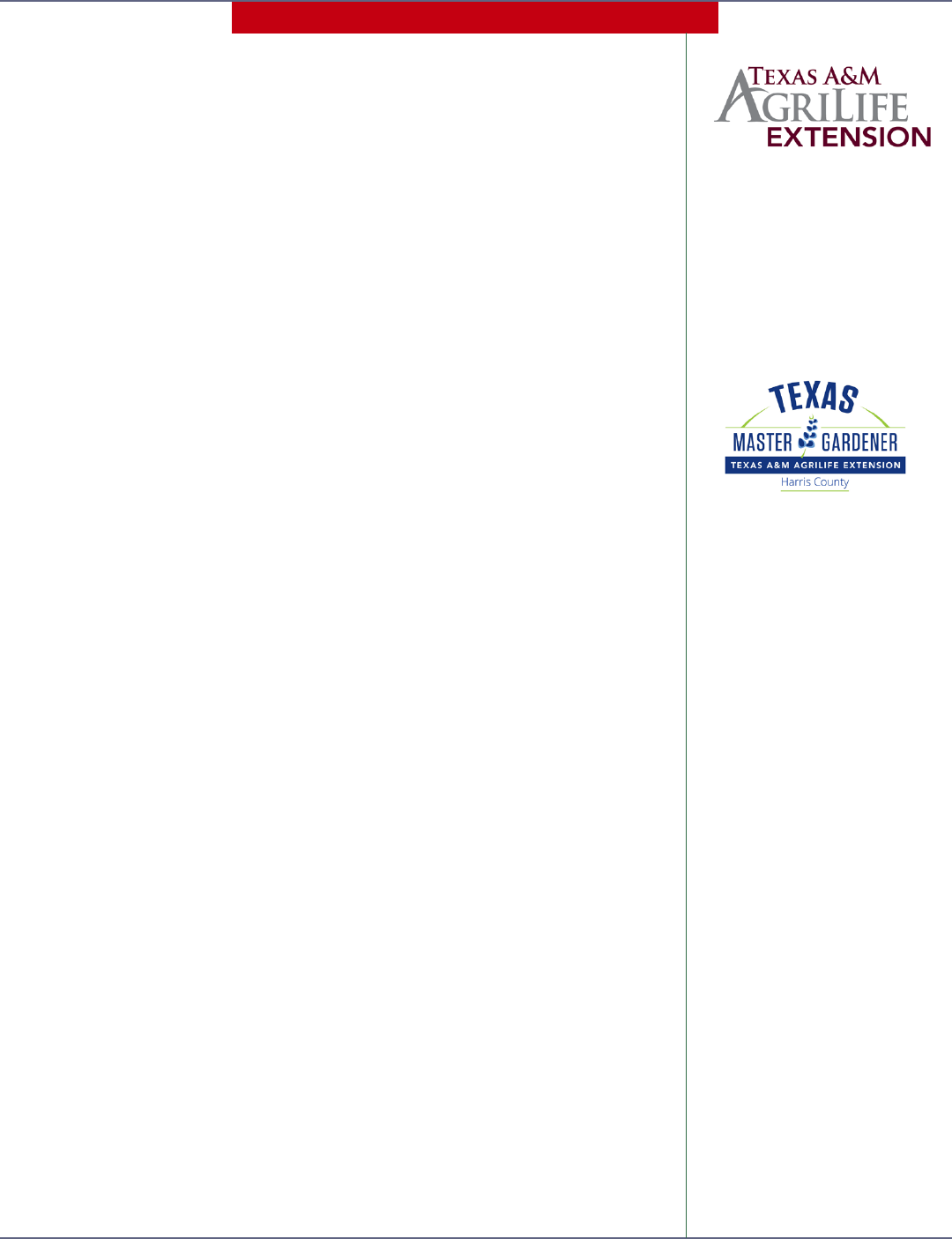
2
URBAN DIRT • FEBRUARY 2020
U E
March 2020
Green Thumb Gardening Series
Herbs
Mar. 12, Barbara Bush Library, 6:30 - 8:30 p.m.
Mar. 17, Spring Branch Memorial Library, 6:30 - 8:30 p.m.
Mar 19, Freeman Branch Library, 6:30 - 8:30 p.m.
Mar. 21, Maude Smith Marks Library, 10:30 a.m. - 12:30 p.m.
Educational Programs
Mar. 12, Second Thursday 10:00-11:30 a.m. Program: Natural Habitats by Tim Pylate,
Armand Bayou Nature Center. Tim will be speaking about benecial and poisonous snakes in
our area. This will be the time of year when they begin to resurface. Tim plans to educate the
public by bringing some snakes to observe too! Genoa Friendship Garden, 1202 Genoa Red
Bluff Rd. Plants for sale in the greenhouse.
Youth Activities
Mar. 24, Growing with Plants & Nature (Formerly Open Garden Day at Weekley Center).
Free for children ages three to twelve. 10:00 to 11:15 a.m. Weekley Community Center, 8440
Greenhouse Rd., Cypress, TX. REGISTRATION IS REQUIRED by Sunday, March 22nd. To
register or for more information: [email protected].
Master Gardener Awards Luncheon
Mar. 11, 11:00 a.m. - 2:00 p.m. Cherie Flores Garden Pavilion, Hermann Park, 1500 Hermann
Drive, Houston 77004. Register by 12 p.m. Noon Wednesday, March 4th. Registration forms are
available at February's First Tuesday meeting, in the Weekly Update emails and on page 9 of this
newsletter.
Texas AgriLife Extension Service
Horticulture Program in Harris County
9449 Grant Rd.
713.274.0950
Houston, TX 77070
Master Gardener Program Coordinator
Brandi Keller - 713.274.0950
CEA – Horticulture
Paul Winski - 713.274.0950
CEA – Horticulture
Vacant
2020 Board of Directors
President
Beth Braun
First Vice President
Alan Fisherman
Second Vice President
Jonathan Correia
Past President
Evan Hopkins
Secretary
Aida Pita
Treasurer
Dianne Lawrence
Directors
Douglas McLeod
Danny Dunn
Janice Muhm
Dana Goeggel
Linda Saxman
Alexa Haass
Marsha VanHorn
Genoa Friendship Gardens
Steering Committee Coordinators
Advisors
Evan Hopkins
Georgia Lau
•
Urban Dirt Editor
Carolyn Boyd
Assistant Urban Dirt Editor
Terri Simon
Visit txmg.org or contact the Harris County Extension Ofce, 713-274-0950,
coordinator[email protected] for information.
February 2020
Green Thumb Gardening Series
Spring Vegetable Gardening
Feb. 13, Barbara Bush Library, 6:30 - 8:30 p.m.
Feb. 15, Maude Smith Marks Library, 10:30 a.m. - 12:30 p.m.
Feb. 18, Spring Branch Memorial Library, 6:30 - 8:30 p.m
Feb. 20, Freeman Branch Library, 6:30 - 8:30 p.m.
Educational Programs
Feb. 4, First Tuesday 12:00 - 1:00 p.m. Program: Master Gardener Program in Harris
County by Brandi Keller, MG Program Coordinator, and Paul Winski, CEA – Horticulture.
Arrive as early as 10:30 a.m. and bring a sack lunch. Trini Mendenhall Community Center,
1414 Wirt Rd, Houston, 77055
Feb. 13, Second Thursday 10:00-11:30 a.m., Program: Purple Martins by Matt Fendley,
Professor, University of Houston Clear Lake. Genoa Friendship Garden, 1202 Genoa Red Bluff Rd.
Plants for sale in the greenhouse.
Youth Activities – DATE CHANGE!
Feb. 12, Growing with Plants & Nature (Formerly Open Garden Day at Weekley Center).
Free for children ages three to twelve. 10:00 to 11:15 a.m. Trini Mendenhall Community Center,
1414 Wirt Road, Houston, 77055. REGISTRATION IS REQUIRED by Monday, February 10.
To register or for more information: [email protected].

URBAN DIRT • FEBRUARY 2020
3
An array of Beth's many garden gloves
P’ P
“It’s the most wonderful time of the year.” So begins a holiday
song made famous by Andy Williams. As a gardener, my favorite
time of the year is early spring. The harbingers of spring draw
me out to the garden, and the dreaming and planning begin.
I’m convinced that a common thread runs through our love of
Before and Afters: The Biggest Loser; The Biggest Little Farm
(a beautiful documentary about farming novices turning a fallow
farm into a productive organic farm); all the renovation programs
on HGTV, PBS and online platforms; makeup, hairstyle and
clothing makeovers in magazines, YouTube, and other websites;
and the list goes on. The essence of all is hope.
Sometimes, a bad situation calls for walking away toward a
better tomorrow, while sometimes the situation calls for a make-
over. Harris County Master Gardeners suffered a major setback
when two calamitous oods claimed our Bear Creek demonstra-
tion and trial gardens plus ofce and meeting spaces. Hurricane
Harvey sealed the decision to walk away from that hub of activity
and community. The Extension staff managed in tight temporary
quarters, while the Master Gardener Association’s nances and
morale took a big hit. Many of you faced parallel experiences
with your own ooded homes and businesses.
I’m happy to report that HCMGA is on better nancial foot-
ing now, thanks to the leadership of previous Boards and to the
work of so many volunteers engaged in fundraising activities. We
operated on a lean budget, and will continue to do so this year.
You carried on the work of our organization, attended meetings,
completed your volunteer and education hours, and even built
up public outreach programs during challenging times. That is
a powerful manifestation of hope and grit. Thank you.
While we had to walk away from our Bear Creek facilities,
the Genoa Friendship Gardens took on new opportunities like
the trial gardens lead by our Extension Agents. In support of that
work, funds were approved last year to begin renovations of the
greenhouse, starting with the roof. The rst action of this year’s
Board was to approve additional funds to complete the exterior
repairs. More needs to be done to restore the interior to full work-
ing order, and the Board will consider those projects after the
spring plant sales.
Speaking of spring plant sales, what better way to celebrate a
new season, interact with the public and fellow Master Gardeners,
promote plants suitable to our climate(s), earn volunteer hours,
and head home with a few plants ourselves, all the while support-
ing the nancial welfare of your Master Gardener Association?
Look for plant sale locations, dates, and volunteer opportunities
on our website or in the Weekly Update emails.
It’s the most wonderful time of the year.
Beth Braun
HCMGA Board President, 2020
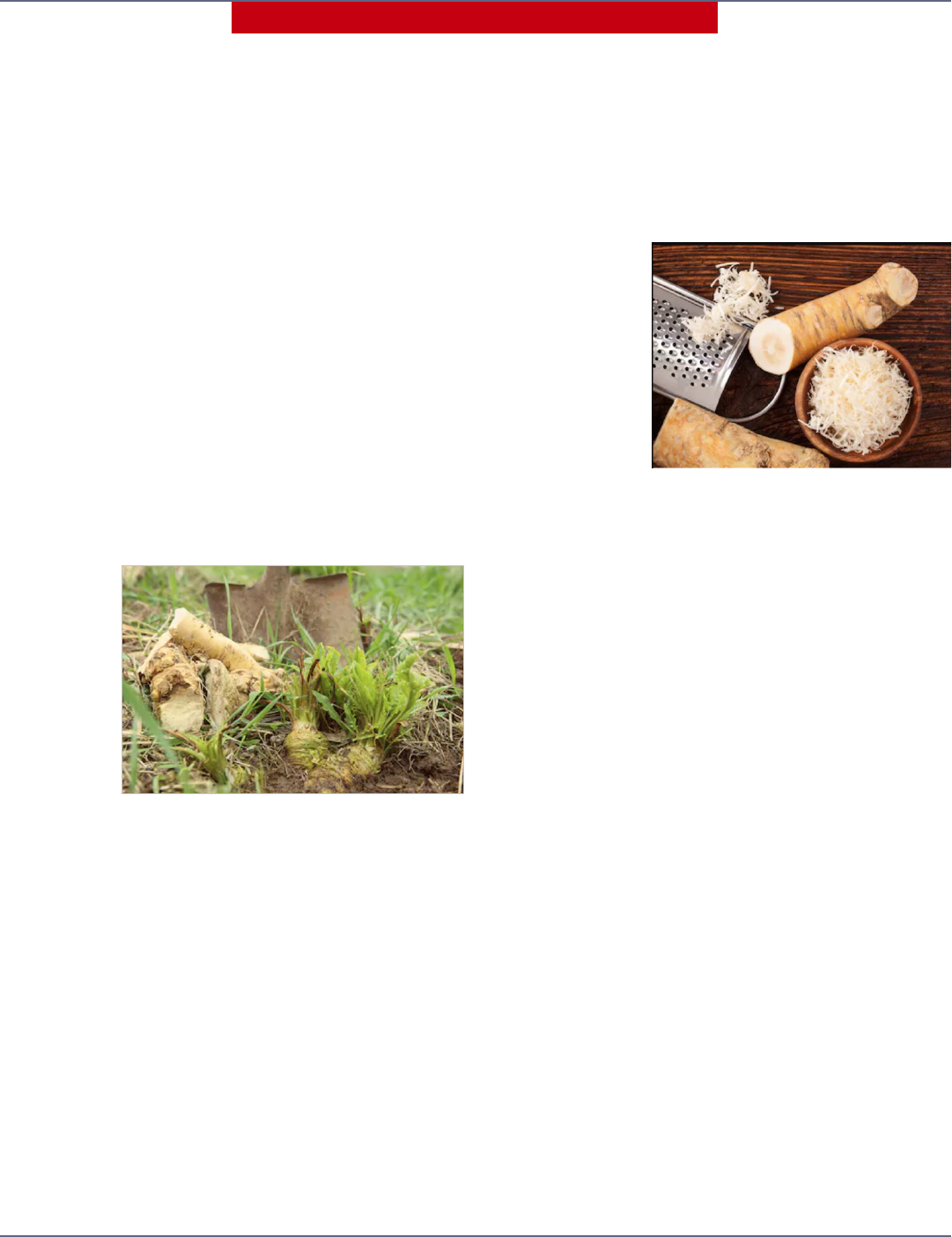
4
URBAN DIRT • FEBRUARY 2020
horseradish, and then
it was only partaken
of by country folk
and laborers. By the
late 1600s, however,
horseradish was a
standard accompani-
ment for beef and
oysters for all Eng-
lish people; in fact,
the root was grown
at inns and coach stations to be used in cordials for weary travel-
ers. Horseradish then made its way to the New World via early
settlers, who cultivated it in the colonies; the herb became com-
mon in the northeast by the early 1800s and began growing wild
near Boston by 1840.
Horseradish is a root crop of the crucifer family. There are two
types of horseradish: common, which features broad, crinkled
leaves, and Bohemian, proffering narrower, smooth leaves. Horse-
radish in Texas can become somewhat invasive once established,
so this should be kept in mind when planting. Fresh horseradish
can be obtained year-round in Texas, although currently it is not
grown commercially within the state. If you do desire to plant the
herb in your garden, do so in well-drained soil, in either full sun or
partial shade, and it should be planted now, in February. Expect a
mature height of up to three feet; new plants regenerate from root
bits that are left in the soil. Horseradish’s leaves have no culinary
value and contain a slightly poisonous compound. To harvest, se-
lecting the roots best for consumption, look for roots that are free
of blemishes and bruises, and that are creamy white in color. The
roots should be turgid and rm upon harvesting, then washed and
peeled before preparation for culinary usage. Harvested horserad-
ish should be used shortly after harvesting. A microplane tool is
excellent for grating horseradish into an edible size and texture.
In the interest of health, horseradish is acknowledged by both
Chinese medicine and Ayurvedic medicine as a tonic healer,
promoting circulation and addressing certain imbalances in the
body. Many would agree that horseradish has a rightful place in
a healthy garden, alongside other herbs and vegetables. Here’s to
your garden and health in 2020!
H M
Horseradish (Armoracia rusticana)
by Karen McGowan, Master Gardener
A three-thousand-year-old plant that has been tapped for many
uses, including an aphrodisiac, a treatment for arthritis, a bitter
herb for Passover, and a snappy sidekick for beef, chicken, and
seafood, horseradish is this month’s herb focus.
While the history of horseradish is somewhat obscure, we do
know that the Egyptians were aware of horseradish as far back as
1500 B.C. Early Greeks prized horseradish’s use as a rub for low
back pain and as an aphrodisiac. Modern-day seders still include
horseradish as a bitter herb. Horseradish has been lauded over the
years as a certain cure for everything from arthritis to tubercu-
losis. According to legend, the Delphic oracle told Apollo, “The
radish is worth its weight in lead, the beet its weight in silver, the
horseradish its weight in gold.”
Over the
years there has
been some dis-
agreement over
horseradish’s
origin; most re-
cent agreement
is that the herb
is believed to
have originated
in Central
Europe. This is also the area linked to the most widely held
theory of how horseradish was named. Horseradish in German is
called “meerrettich” (sea radish) because it grows by the sea. The
migratory transition to “horseradish” for Armoracia rusticana is
believed to have followed the English misprouncement of the
German word “meer,” which became eventually known as “mare-
radish.” The word “horse” as applied to “horseradish” is thought
to denote its large size and coarseness. “Radish” is taken from the
Latin radix meaning root.
Horseradish made its way through the Renaissance, consumed
throughout Central Europe northward to Scandinavia and west to
England. In 1640 is the rst documentation of British consuming
Grated horseradish
Horseradish roots
Citations:
www.horseradish.org
www.extension.psu.edu
www.aggie-horticulture.tamu.edu
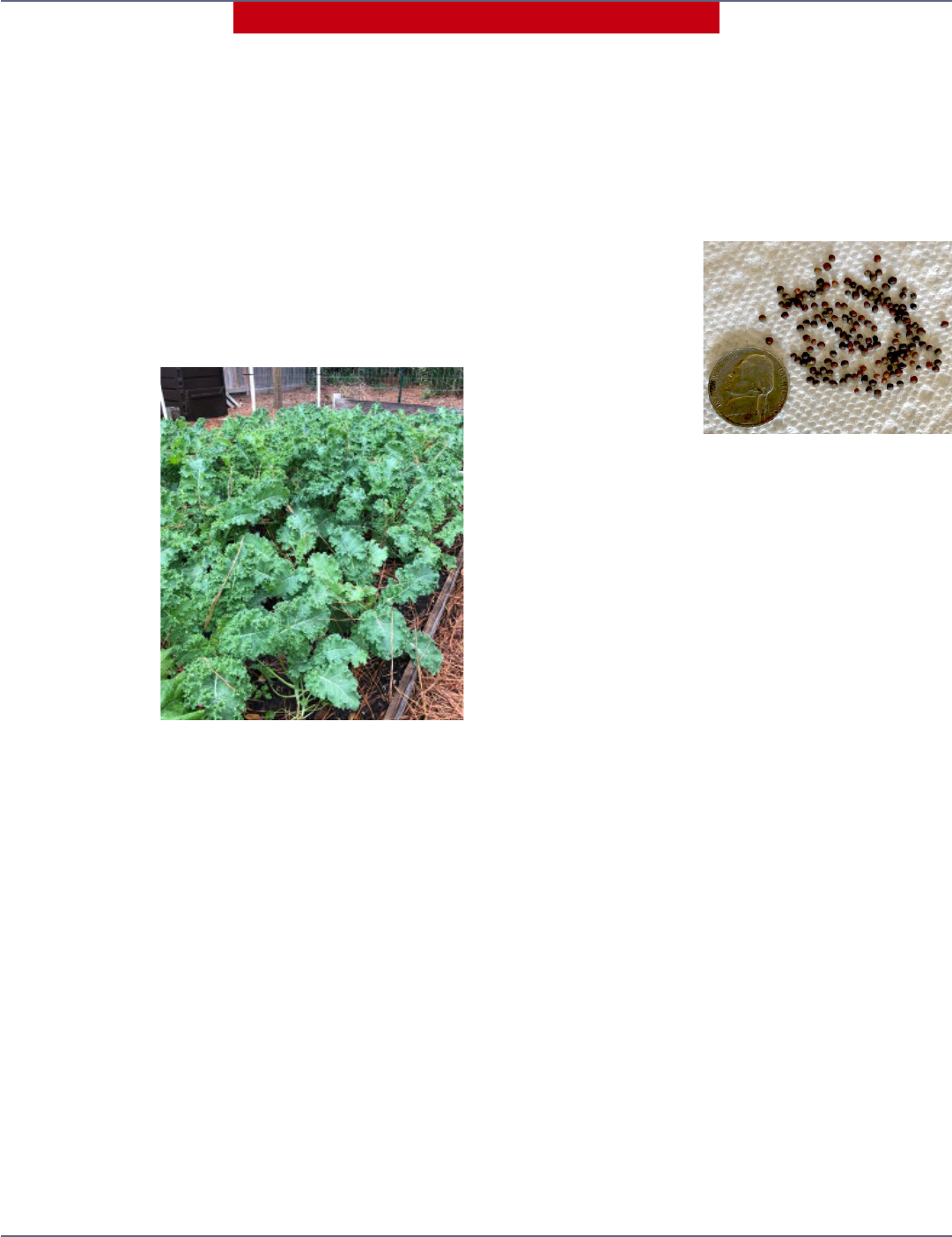
URBAN DIRT • FEBRUARY 2020
5
Because of the variability
of seeding, one has to over-
seed and then thin out as the
seedlings emerge. Thin-
ning is a common practice
in home gardening but it
can be avoided if one uses
transplants. One additional
challenge to sowing small
seeds is the heavy downpours
we often experience in the Houston area. These seeds are typically
no deeper than a 1/4" to 1/2" which is a tedious exercise. These
seeds can be easily dislodged if these heavy rains occur shortly
after sowing. I had that very experience this past fall and had to
re-seed part of my beds to ll in for seeds dislodged due to a heavy
rainstorm. I also had kale coming up in areas where I did not plant
kale!
Using transplants eliminates the problem outlined above with
sowing but adds challenges of a different sort. First, purchasing
transplants are far more costly than individual seeds. A packet of
kale seed is roughly $5.00 for 2,000 seeds, whereas kale trans-
plants cost around $2.00 to $3.00 per plant. Secondly, you can
only plant the kale available at your nursery instead of trying the
many varieties available from seed suppliers. Growing your own
seedlings takes some extra supplies and requires a suitable loca-
tion for germination not to mention a little patience, but can also
be very rewarding. Or, you can roll the dice as I do and sow the
seeds directly.
Most resources state kale will grow well in full sun to semi-
shade. You can nd a wide variation in planting recommendations
online but, generally plants are spaced one to two feet apart with
rows two to three feet apart. Glancing back at my kale patch, one
might argue I have them packed in pretty tight.
My experience is kale is a low maintenance plant. I typically
start to see problems with insects once we get into early sum-
mer, when every insect known to mankind seems to nd its way
into my garden. The Old Farmer’s Almanac and other resources
P M
Kale
by Don Tyler, Master Gardener
A quick glance at Texas A&M AgriLife Extension’s Vegetable
Garden Planting Dates for Harris County
1
calendar, the month
of February is the heart of planting the early spring vegetables
such as beets, broccoli, brussels sprouts, cabbage, kale and swiss
chard, just to mention a few. I use the term early spring veg-
etables but many, if
not most of these,
were fall vegetables
as well. Seeing we
have relatively mild
winters in Harris
County, many of
these early spring
vegetables are, from
my perspective,
carry-overs from
the fall garden. For
me, kale falls in this
carry-over category.
The picture is my
kale patch in January
but planted in the fall. I just keep on harvesting til early summer.
Texas A&M AgriLife Extension’s Recommended Vegetable
Varieties for Harris County
2
shows the following varieties of
kale – Dwarf Blue Curled Scotch, Dwarf Blue Curled Vates and
Green Curled – perform well in our area. The picture above is the
Dwarf Blue Curled Vates variety.
Another item to keep in mind is the planting dates calendar
emphasizes if you plant in the February timeframe, you need to be
using transplants. The reasoning is to get a good harvest prior to
the dog days of summer when kale takes on a stronger bitter taste
and leaves get tough.
I sow seeds directly in my garden beds with good success, but
there are advantages to using transplants. Like many leafy green
vegetables’ seeds, the seeds are very small and so there are obvi-
ous challenges in placing those seeds.
1
http://counties.agrilife.org/harris/les/2019/03/Vegetable-Planting-Chart-2019.pdf
2
http://counties.agrilife.org/harris/les/2018/07/2017-Vegetable-Varieties.pdf
3
Growing Kale”, The Old Farmer’s Almanac, https://www.almanc.com/plant/kale
4
Gunnars, Kris. “10 Health Benets of Kale”. Healthline. June 29, 2018. https://www.healthline.com/nutrition/10-proven-benets-of-kale
Kale seeds Photo by Don Tyler
cont'd on pg. 6
Kale patch Photo by Don Tyler
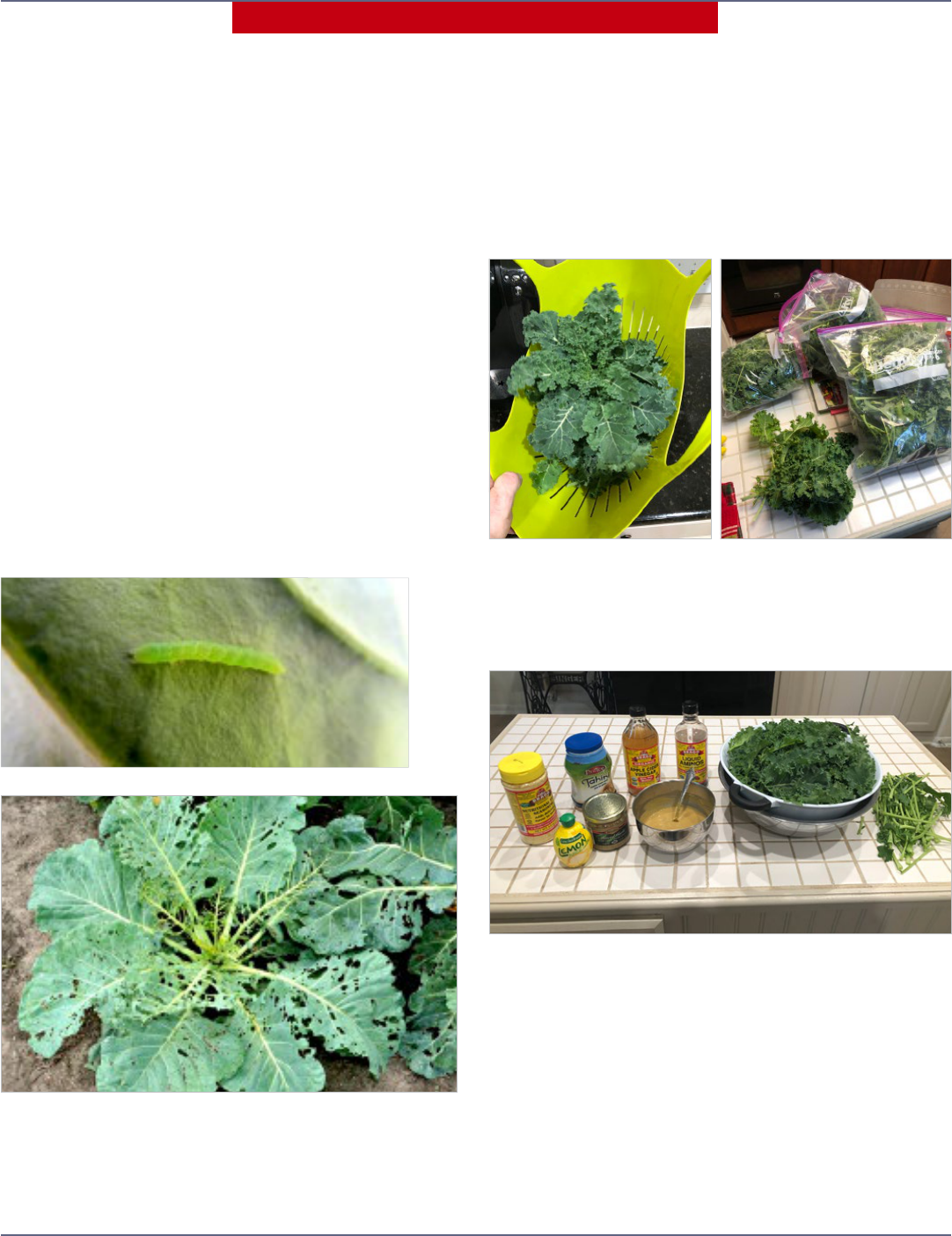
URBAN DIRT • FEBRUARY 2020
6
Kale, cont'd from pg. 5
mention three primary pests, “cabbage worms, ea beetles and
aphids”
3
. As with many insects in my garden, I see the results
more than I see the culprit. In my case, the leaves were being
chewed and upon very close inspection, I found cabbage worms.
A quick side note. My rst experience with cabbage worms
was at a semi-fancy local organic restaurant when my wife
ordered a kale salad. It was denitely fresh kale with a cabbage-
worm thrown in for good measure. We all had a good laugh….the
little guy was clean! Of course, that is easy for me to say. I wasn’t
the one eating the kale salad.
The following pictures, taken from The Old Farmer’s Alma-
nac, are of a cabbageworm and a perfect example of the resulting
damage. If I had a picture of my kale (late season), the picture be-
low would be a perfect representation. For me, it is not a big deal
as early summer is about the time I pull up all my plants anyway.
If you are like me and not really into precious little insects,
there are several recommendations for control of cabbage worms
with most recommending spraying with Bt (Bacillus thuringien-
sis). As with all pesticides, we should always follow the directions
provided on the label.The following shows an ample day’s har-
vest, bagged and ready to share with neighbors.
The Healthline website lists kale as “among the most nutrient-
dense foods on the plant”
4
. There are several kale salad recipes
online and directions on how to make your own kale chips.
If you have not done so already, kale is a great crop to add to
your early spring garden, not to mention your diet!
Cabbage worm Photo courtesy Old Farmer's Almanac
Harvested kale Photo by Don Tyler
Favorite Tyler family kale salad recipe, Garlicky Kale from Whole Foods,
https://www.epicurious.com/recipes/member/views/garlicky-kale-from-whole-
foods-52343451. Photo by Don Tyler
Cabbage worm damaged kale Photo courtesy Old Farmer's Almanac
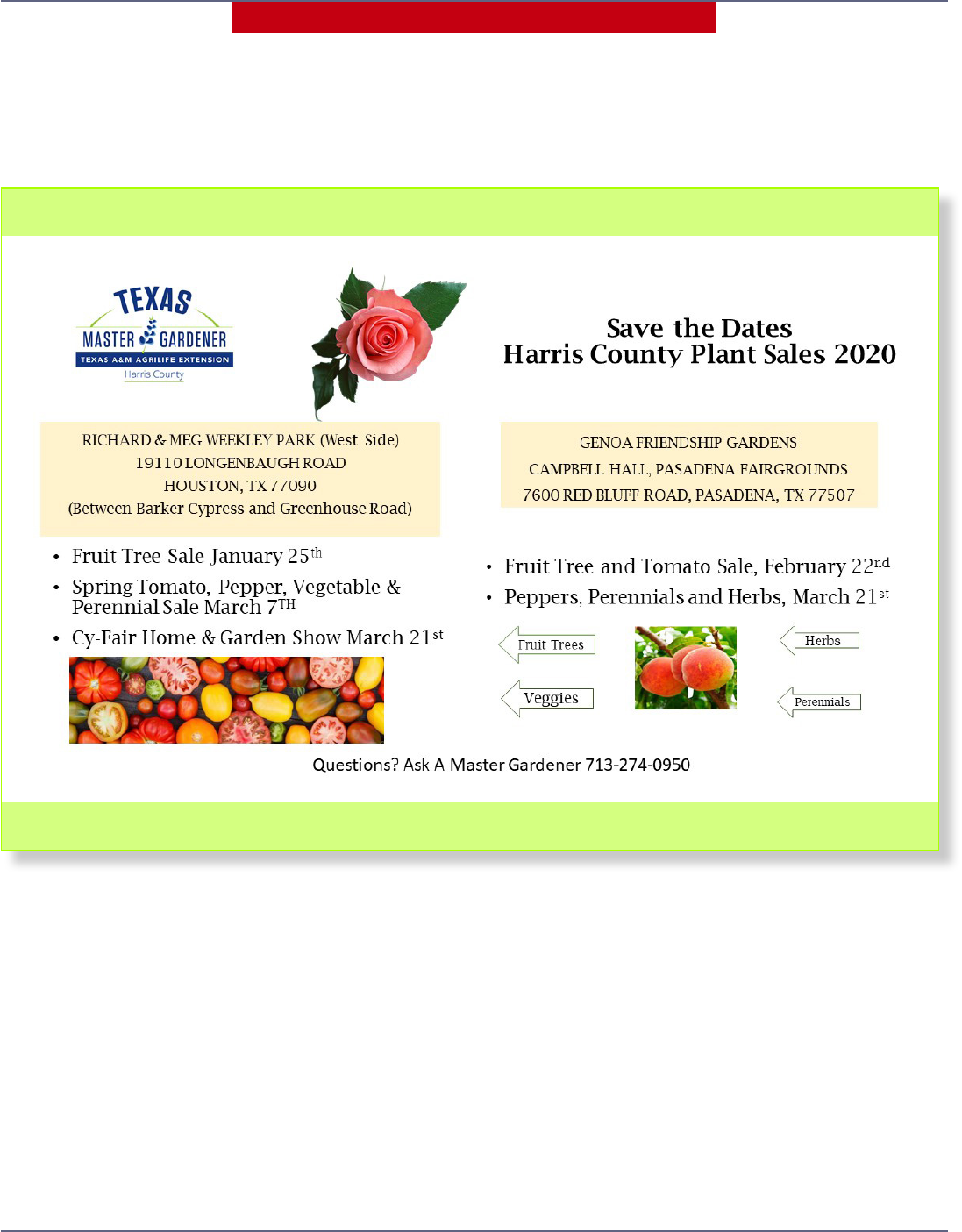
URBAN DIRT • FEBRUARY 2020
7
2020 H C M G P S
Genoa Friendship Gardens Sales
Campbell Hall, Pasadena Fairgrounds, 7601 Red Bluff Rd., Pasadena 77505
Feb. 22, 9:00 a.m. - 1:00 p.m. Fruit Tree, Tomato Sale - Citrus, apples, peaches, pears, berries,
gs, avocados and tomatoes suitable for our area.
Mar. 21, 9:00 a.m. - 1:00 p.m. Peppers, Perennials and Herbs Sale
West Side Sales
Mar. 7, 9:00 a.m. - 1:00 p.m., Spring Tomato, Pepper, Vegetable & Perennial Sale
Richard and Meg Weekley Park, 19110 Longenbaugh Rd, Houston 77090
(between Barker Cypress and Greenhouse Road)
Mar. 21, 9:00 a.m. - 6:00 p.m. Cy-Fair Home & Garden Show, The Berry Center, 8877 Barker Cypress Rd, Cypress, TX 77433
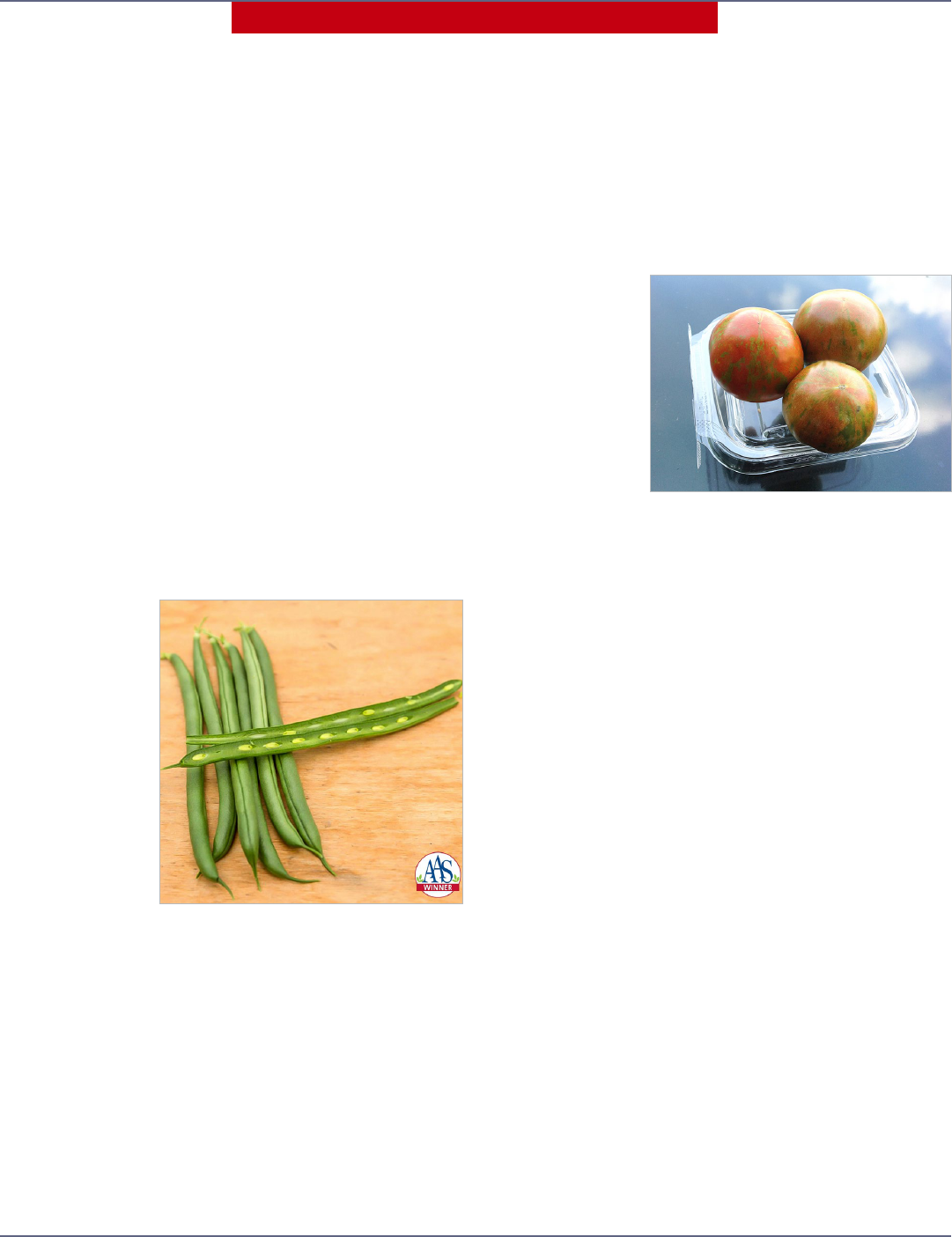
8
URBAN DIRT • FEBRUARY 2020
Planning for Spring, cont'd from pg. 1
and outside? If you grew anything in that bed last year, your soil is
tired and anemic! Get rid of all the weeds, break up that soil and
amend it. Compost, worm castings, azomite, nd a combination
that works for you. Amending your soil is also necessary if you
have had heavy rains that washed out your nutrients. If you have
enough space, you can let one or more beds lie fallow and rotate
but I know that is not always possible. The majority of my plants
are in pots, so I denitely have to “revive” their soil also.
While poring through my catalogs and browsing on the
internet, I have noticed several vegetable varieties that caught my
eye. Some are new discoveries, some are new hybrids and some
are new introductions which other gardeners have tried with great
success and the word has spread.
“Seychelle” pole beans are a vegetable now offered in several
seed catalogs. Selected as an AAS (All American Selections)
winner, the beans produce well, taste great and are stringless with
small beans inside
the pod.
Grown in Utah
but originally from
Indiana, Baker Creek
Heirloom Seeds
offers “Astronomy
Domine” corn, a
beautiful sweet corn
that is supposed to
ripen mid-season. me
of the kernels remind
me of beautiful am-
ethyst gems nestled
within their shucks.
Several growers are offering “Sarandipity” tomato seeds. The
dwarf tomato is chocolate with green stripes. It is a cross between
a “Streaky” tomato in the Cheeky family and a Black Zeba. The
plant is a heavy
producer with fruits
ranging from 2-4
ounces.
The last plant
that caught my eye
is technically a fruit,
but cucumbers are
a popular plant that
are grown in many
home gardens.
The “Dragon Suhyo” cross cucumber has thin skin that requires
no peeling and has a crunchy bite. It came from China and has
prominent ribbing.
These vegetables and fruit caught my eye because I like unique
colorful plants. Feel free to try something new this year. Every year
I try to expand my horizons and try a new plant variety. Of course,
it’s usually a basil and a pepper, but that’s a given. I usually try
something else as well. This year is no exception.
Whatever you decide to plant, whether it’s the usual plants or
something new or a combination, enjoy your produce. It may be
hit or miss with new varieties, but at least you have stepped outside
your comfort zone. Happy gardening!
All-American Selections Seychelle pole beans
Photo courtesy all-americanselections.org
Sarandipity Dwarf tomato
Photo courtesy renaissancefarms.org

URBAN DIRT • FEBRUARY 2020
9
Harris County Master Gardener Association
invites you to join us at our
Annual Awards Luncheon
Wednesday, March 11th, 2020
Cherie Flores Garden Pavilion, Hermann Park
1500 Hermann Drive, Houston, TX 77004
Centennial Garden Parking lot is located on Hermann Drive
(cross street is Crawford St.)
• Check-in at 11:00 a.m.
• Catered Buffet at 11:30 a.m.
• Program begins at 12:00 p.m.
• Garden Tour following luncheon at 2:00 p.m.
• $15 per person
• Register by
12 p.m. Noon Wednesday, March 4th
Individuals with disabilities who require an auxillary aid, service or accomodation in order
to participate in any Extension activities, are encouraged to contact the County Extension
office for assistance eight days prios to the acitvity.
2020 HCMGA Awards Luncheon Reservation Form
Reservation and payment can be made to Membership at the February 4th
First Tuesday meeting, or mail for receipt by Tuesday, March 4th to:
Attention: Awards Event, HCMGA, 15719 Echo Canyon Dr, Houston, TX 77084
Please email questions to Karen at kmbrene@att.net
Name: _____________________________________________________ Phone:___________________________
Number
attending __________________________________________ Vegetarian
£
Amount enclosed_________________
MASTER GARDENER
Harris County

10
URBAN DIRT • FEBRUARY 2020
Ask a Master Gardener is a volunteer program offered by Texas A&M AgriLife
Extension Service. Volunteers staff booths and tables to provide free, research-based
horticulture education to the public throughout Harris County.
In February we are going to be in the following locations!
Feb. 1 Urban Harvest - 1st Saturday, 7:30 a.m. - 12:00 p.m.
3401 Westheimer Rd. (corner of Buffalo Spdwy. & Westheimer), Houston
Garden Oaks/Heights - 1st Saturday, 8:30 a.m. - 11 a.m. at The Farmstand,
938 Wakeeld, Houston
Feb. 8 Tomball - 2nd Saturday, 8:30 a.m. - 1 p.m. at 205 W. Main Street, Tomball
Feb. 20 Westchase - 3rd Thursday, 3 - 7 p.m. at 10503 Westheimer Rd., Houston
Feb. 22 Memorial Villages - 4th Saturday, 8:30 a.m. - 1 p.m. at 10840 Beinhorn Rd.,
Houston
Towne Lake - 4th Saturday, 2:30 - 7 p.m. at 9955 Barker Cypress Rd.,
Cypress
Ask a Master Gardener
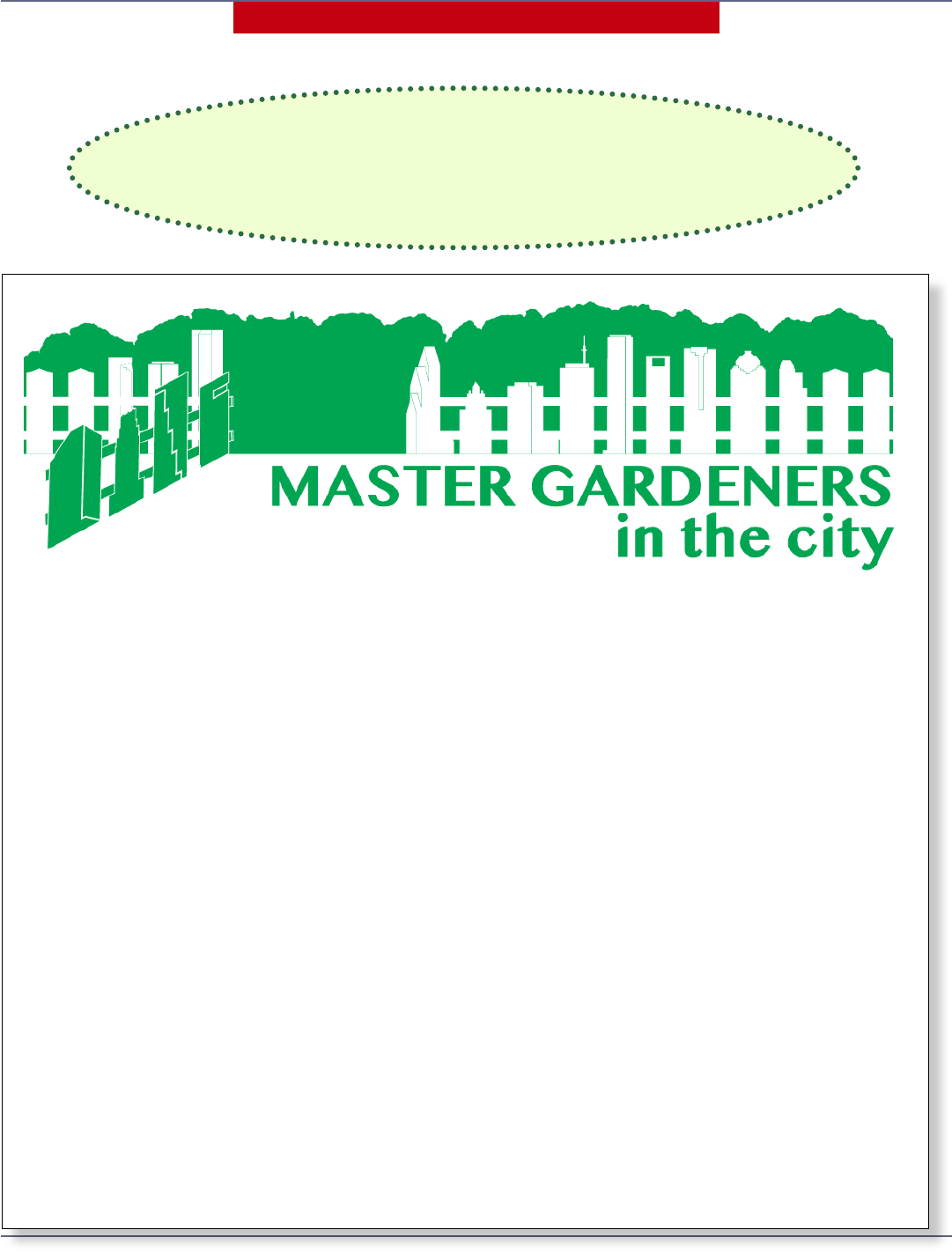
URBAN DIRT • FEBRUARY 2020
11
Texas A&M AgriLife Extension
in partnership with
Hermann Park Conservancy
are pleased to present
Master Gardeners in the City
at McGovern Centennial Gardens
These educational programs are FREE and OPEN TO THE PUBLIC.
Extension programs serve people of all ages regardless of socioeconomic level, race, color, sex, religion, disability or national origin.
The Texas A&M University System, U.S. Department of Agriculture, and the County Commissioners Courts of Texas cooperating.
Saturday, February 8th & 22th
McGovern Centennial Gardens at Hermann Park
1500 Hermann Drive
Houston, Texas 77004
Free tours and children’s activity. Adult workshop at 10:30 a.m.
No registration required.
Visit the Harris County Master Gardeners
Facebook page for event details!
www.facebook.com/HarrisCountyMasterGardeners
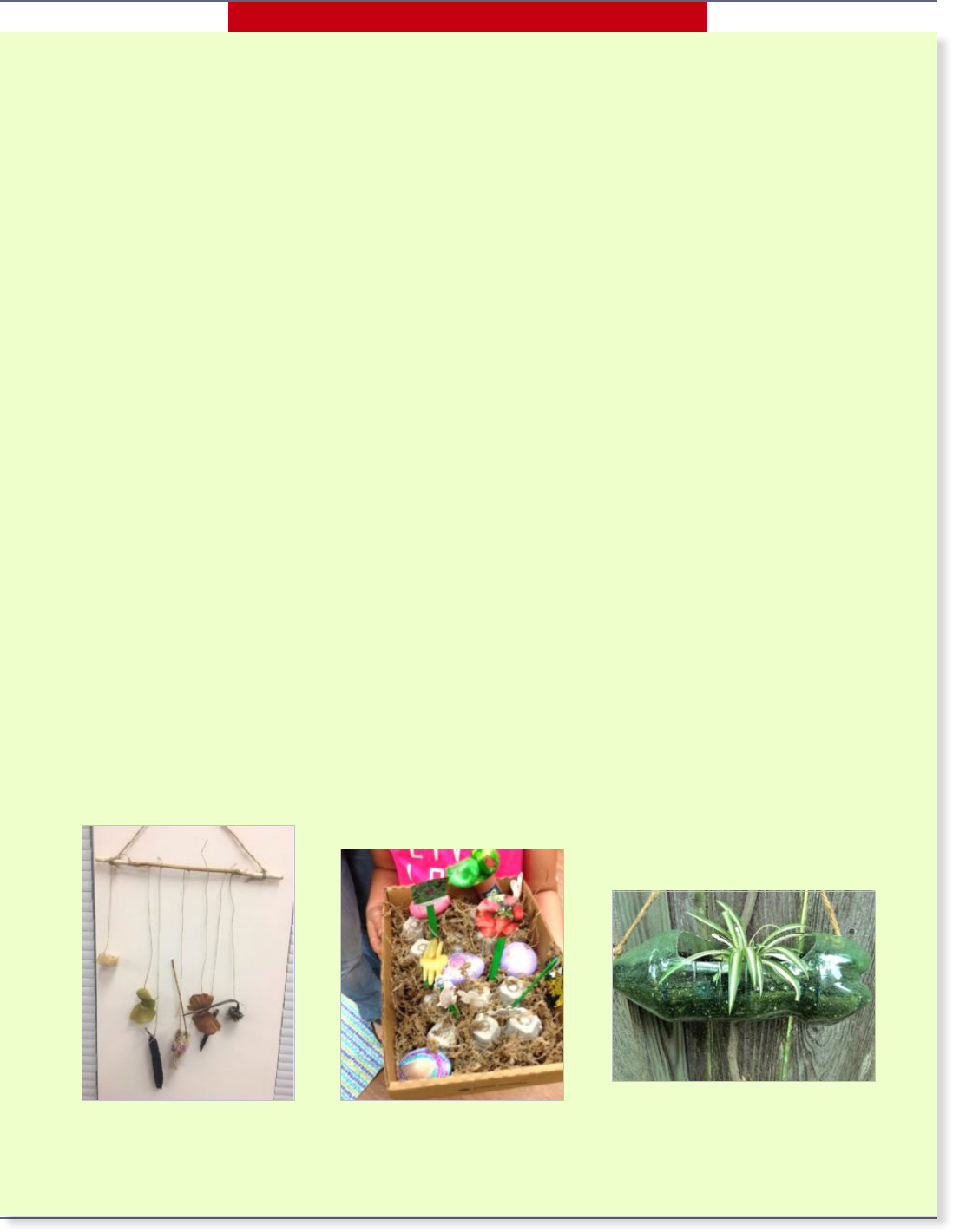
12
URBAN DIRT • FEBRUARY 2020
Growing with Plants & Nature
Texas A&M AgriLife Extension Service and Harris County Master Gardeners
invite you to join us one day each month, January through November, 10:00 –11:15 a.m.
Free for children ages three to twelve. REGISTRATION IS REQUIRED. To register or
for more information: [email protected]
For information about upcoming topics, dates and registration, please email us at
[email protected]. Registration is required before each program.
Children and their parents looking for hands-on ways to learn, create, and have fun inspire
our Growing with Plants & Nature volunteers to offer programs that do just that.
This FREE monthly children's event includes a variety of activities:
• Planting seeds, veggies or ornamentals into pots so children can continue to grow
them at home.
• Creating a "nature theme" craft project with materials that are provided.
• 30-40 minute hands-on lesson that focuses on a single topic each month.
Previous lessons have included making a worm farm, putting together a compost bin,
learning about the importance of butterflies, and making a feeder to attract pollinators.
Recycled soda bottle
Past projects
Fantasy GardenSeed Pod mobile
February - DATE CHANGE!
Wednesday, February 12 - Trini Mendenhall Community Center, 1414 Wirt Rd.
REGISTRATION required by Monday, February 10.
March
Tuesday, March 24 - Weekley Community Center, 8440 Greenhouse Rd. Cypress, TX
.
REGISTRATION required by Monday, March 22.
(The Open Garden Day children's activities program name has changed to be more reflective of its mission.)
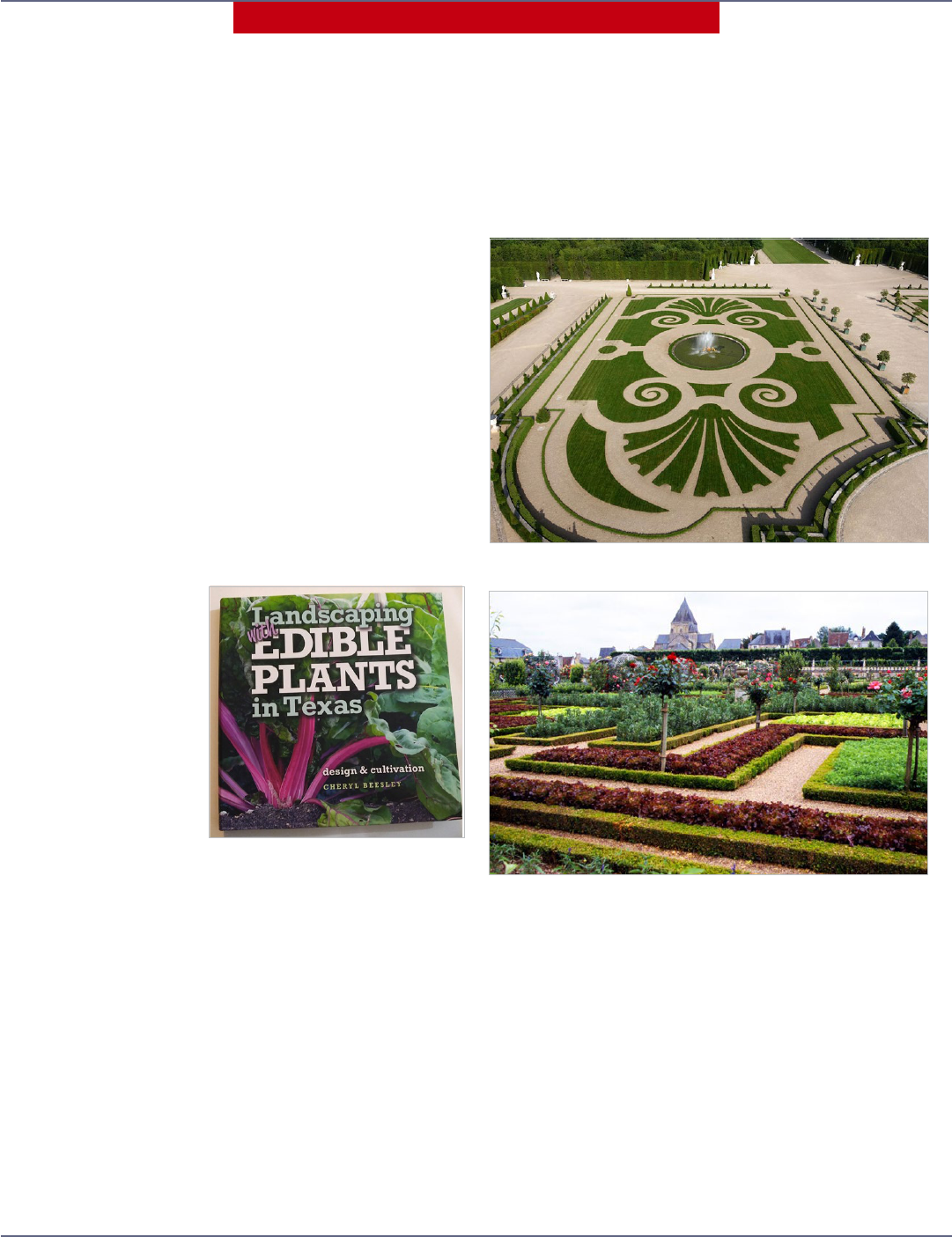
URBAN DIRT • FEBRUARY 2020
13
What a bit of luck I had at the 2019 Texas Master Gardener
Conference in Victoria, Texas. I picked up the perfect reference
book for this month’s vegetable issue. Landscaping with Edible
Plants in Texas written by Cheryl Beesley in 2015, published
by Texas A&M University Press (ISBN #978-1-62349-321-9).
Cheryl is an Austin landscape designer specializing in edible
landscapes, and her company is Adalante.
The book has a wealth of useful information, but I want
to caution those of you who live in areas with Home Owners
Associations (HOAs). Read their rules carefully before you
decide to adopt an edible landscape for your yard.
Cheryl’s book covers hardiness zones, agricultural regions,
annual rainfall and chill hours among other topics. Plant size,
accessibility, scale, and structural elements are mentioned. She
thoroughly covers soil
preparation and fertiliza-
tion. Suggestions for types
of irrigation are useful
and her design elements
discuss form, color, size
and texture. One of my
favorite sections was the
color information for plants.
She sorts the edible plants
according to color to help
you plan your landscape.
Purple plants such as artichokes, eggplant and even a purple
cauliower variety are mentioned. Yes, I like purple.
Do you know the difference between a parterre and a potag-
er? I didn’t, but I do now. Both styles were popular in Renais-
sance times. Your garden or potager can be very close to the
back door, as a “kitchen garden”. The ofcial French term for
a kitchen garden is potager. According to Merriam-Webster, a
parterre is “an ornamental garden with paths between the beds.”
And, a potager can be a parterre. Geometric styles may be
used and parterre gardens can be elaborate. Famous parterre
gardens include the ones at Versailles, the Palais des Tuileries
and Vaux-le-Vicomte in France. The Ornamental Kitchen Garden
at Chateau Villandry in France is a popular tourist site. Many of
the beds have geometric shapes, some shaped in crosses. Forty
Landscaping with Vegetables
by Terri Simon, Master Gardener
vegetable varieties are used and there are two plantings each
year. In the photo included, the vegetable beds are bordered in
boxwood and have edibles with bright colors in the center. It is
considered a potager parterre. Naturally, your garden doesn’t
have to be that complex.
Specic vegetable varieties suitable for Texas are mentioned
in the book. It lists fruits as well. Appendix A has a list of hybrid
varieties. Do you have more exotic tastes? There are recommen-
dations for a Japanese tea garden. My very favorite garden that I
think children would enjoy is a pizza garden.
If you are looking for a good reference book and are interest-
ed in planting an ornamental, edible garden, this book is a great
addition to your library.
Photo by Terri Simon
Latona's Parterre at the Gardens of Versailles in France
Photo courtesy of en.chateauversailles.fr
Vegetable beds at Villandry Photo courtesy of glackgold.bz
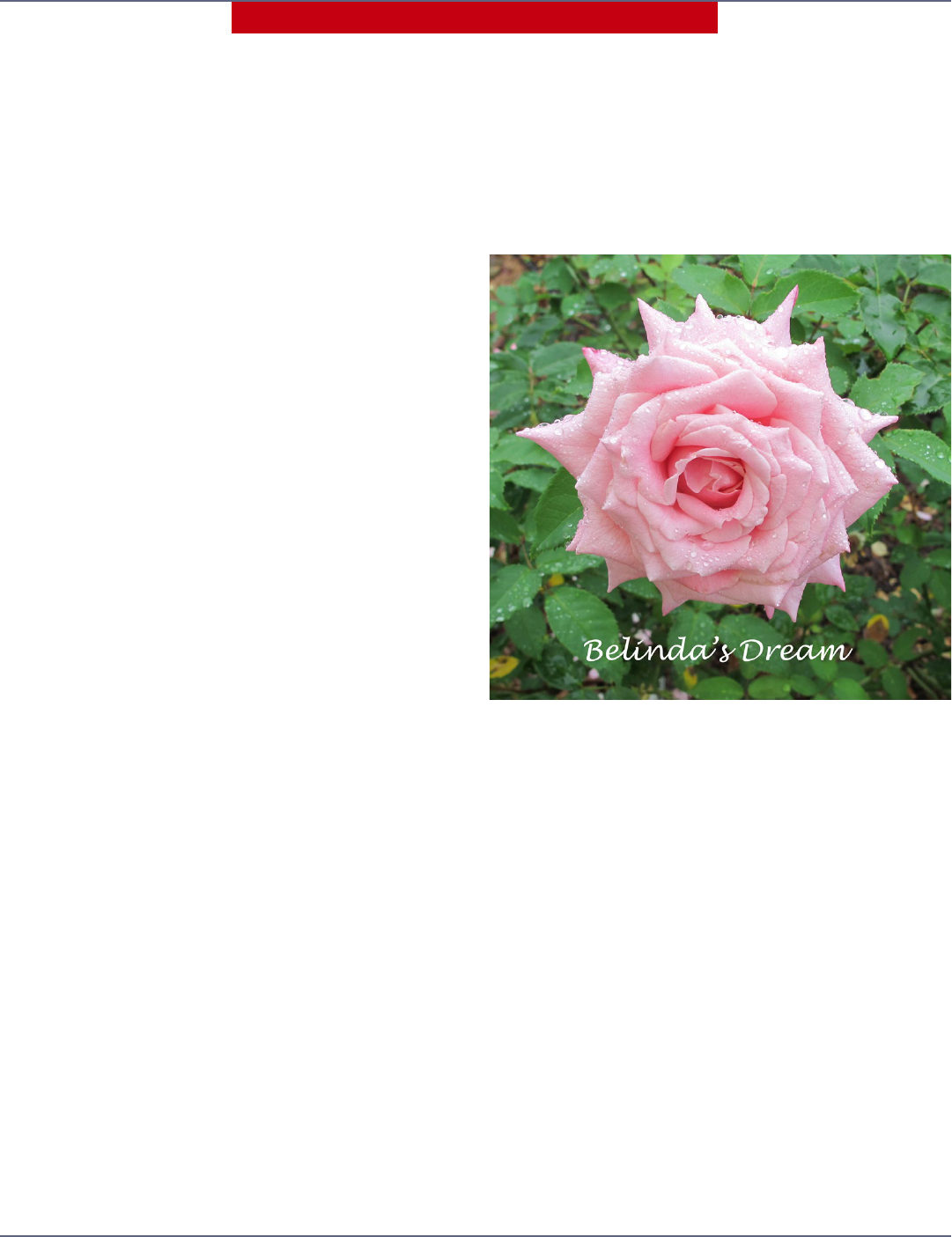
14
URBAN DIRT • FEBRUARY 2020
e Rose Corner
by Christa Kaiser, Master Gardener
There is still enough time to build a new rose bed. Remember
to build beds above ground; the grass can be killed by laying
down a layer of newspapers. Having a border is preferable, it
keeps the lawn out. The site should have at least six hours or
more of sun per day, and make sure there is a reliable watering
system available. Add enough soil, as new soil can settle 4 inches
in the rst year.
To plant bare root roses, ll a bucket full with water and add
SUPERthrive (follow label instructions). Place the roses so that
the water covers the roots for at least one hour. Prune off dam-
aged roots and carefully prune the top. Dig a hole in the shape of
a large pot and build a hill in the middle. Set the bush on the hill,
and backll with soil and water. On grafted plants there will be a
shank starting just above the roots leading upwards to the crown.
Leave the crown elevated with the shank exposed. This way you
will have enough room to add mulch for several years.
To plant rooted roses, remove the pot carefully and do not
disturb the roots. Make a hole larger than the root ball; carefully
set the plant in the middle, backll with soil and water. Press
down the soil around the plant, just a little, to avoid air pockets.
Do not fertilize yet!
The time to prune your roses is around Valentine’s Day for
blooming time in late April.
Here are the basics:
• Clean your rose garden beds, pull all the weeds before
they go to seed.
• Plant new roses or move them.
• Bare root roses should be planted in February.
• Transplant your rose bushes without pruning them,
prune them later!
• Begin your spray program after pruning. Fertilize
established roses.
What to do in February-March
Disinfect your pruning tools!
Prune to remove dead, damaged, diseased, old and central
crossing canes and suckers.
Remove about one third of the outer ends of the remaining
healthy canes (Old Garden Roses). Flowers should be removed and
cuts should be made just above an outward pointing eye. Prune
climbing roses after the rst ush of bloom. Some miniature shrubs
can be pruned with garden sheers. Pruning Hybrid Tea Roses is a
little more complicated. There are great demonstrations on YouTube
or you can contact one of the Houston Rose Society Consulting
Rosarians, www.houstonrose.org/hrsconsl.htm.
The Houston Rose Society has Demonstrations in
February; please check their website for time and location,
www.houstonrose.org.
Have a wonderful 2020!
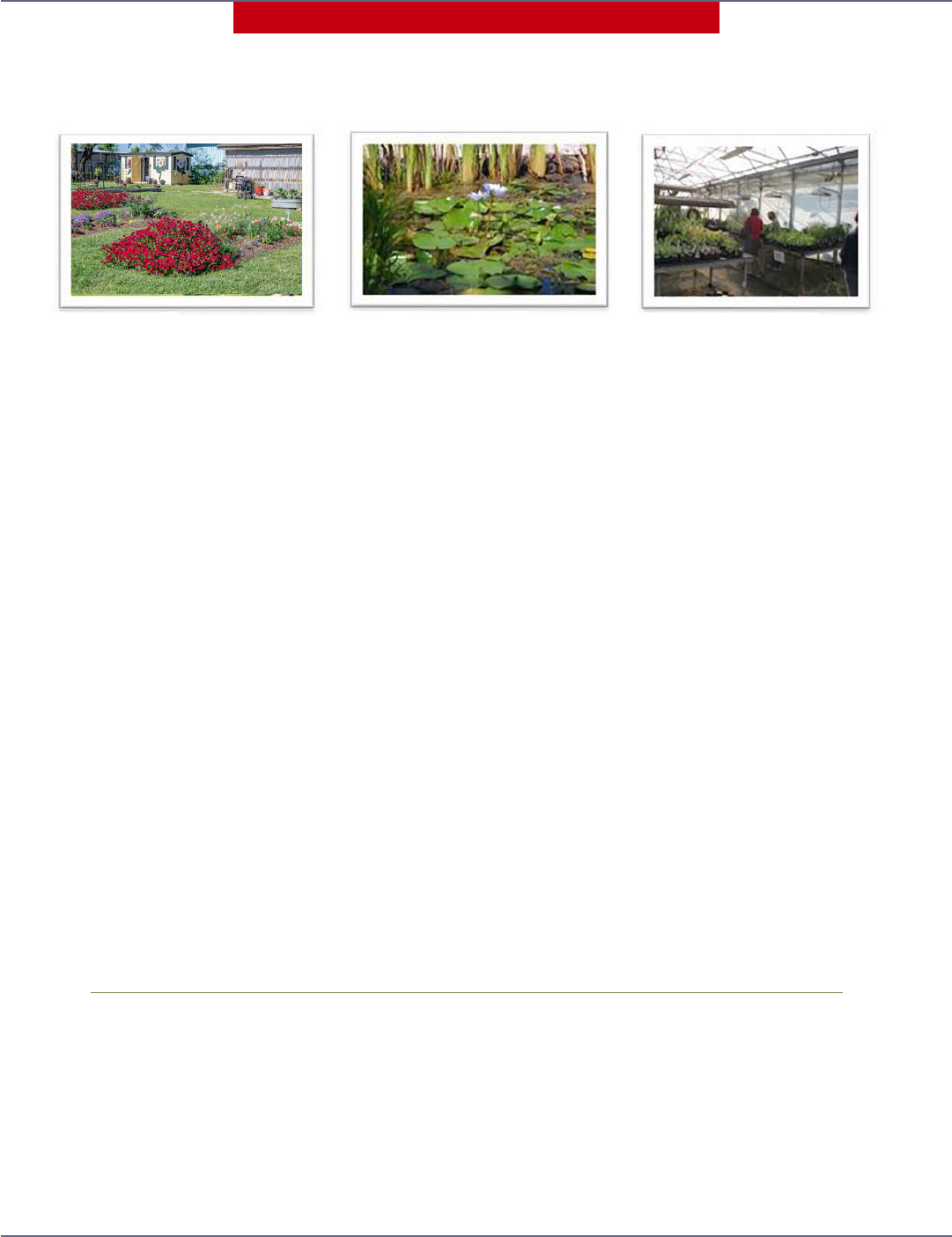
URBAN DIRT • FEBRUARY 2020
15
Open Garden Days at Genoa Friendship Gardens
The Texas A&M AgriLife Extension Service and Harris County Master Gardeners
invite you to join us for
The Genoa Friendship Gardens
is located at
1202 Genoa Red Bluff Road
Houston, Texas 77034
To schedule a special event for your garden club, school or professional organization
please email [email protected] to make your arrangements.
• Tour the variety of exhibits to inspire you with vegetable, perennial, rose, tropical
and native gardens.
• Meet and talk with a Master Gardener about planting citrus, fruit or berries for
your home orchard.
• Contemplate the joy in the Serenity Garden and catch a view of the Water Garden.
• Don't leave the GFG until you have shopped the Greenhouse where seasonal herbs,
vegetables and perennials are available for sale until September.
2020 Monthly Open Garden Days & Special Events
February 22 Fruit Tree Sale June 15 Open Garden Day
March 16 Open Garden Day July 20 Open Garden Day
March 21 Spring Plant Sale August 17 Open Garden Day
April 20 Open Garden Day September 21 Open Garden Day
May 18 Open Garden Day October 19 Open Garden Day
The Perennial Trial Garden
The Water Garden
The Greenhouse
on the 3rd Monday of the month, March through October, 8:30 a.m. – 11:00 a.m.
Admission to the Exhibit Gardens is free. Register at the Welcome Table
to receive additional monthly notices for children and family events.
Open Garden Days
Second Chance Sale bargains can be found in the Greenhouse after our February and March plant sales.
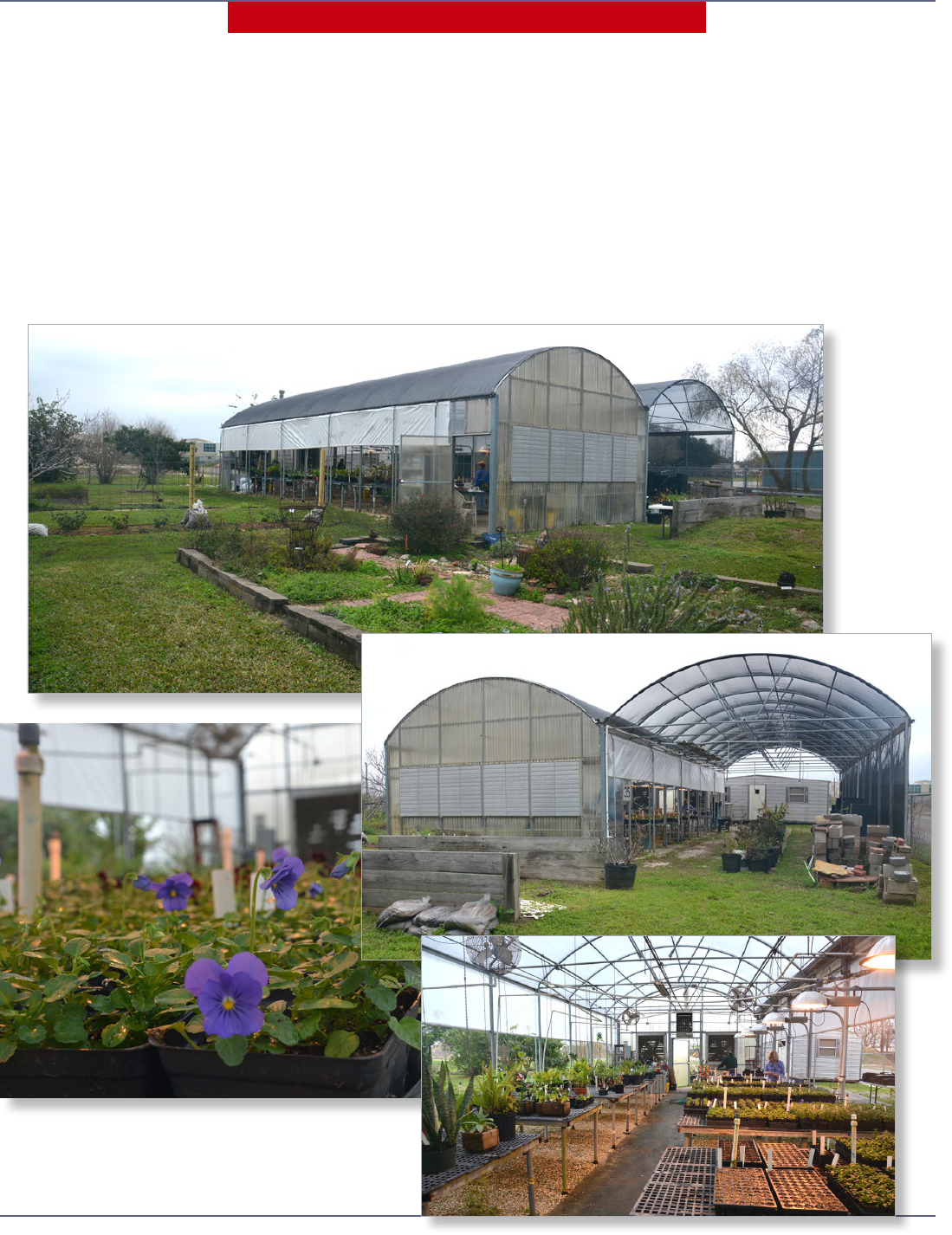
16
URBAN DIRT • FEBRUARY 2020
Genoa Friendship Gardens - Greenhouse update!
Thanks to generous donations by individual Master Gardeners
and HCMGA budget approvals, the GFG greenhouse rehabbing
is progressing nicely. The most dramatic improvement is the new
top for the main greenhouse and a top shade cloth for the side
area. And now, the side panels can be rolled up by one person
with a mechanical crank instead of needing a group of master
gardeners to roll them up manually!
by Carolyn Boyd, Master Gardener
Violas, freshly potted for the Perennial/Annual Trial Garden, are
thriving in the improved greenhouse environment.
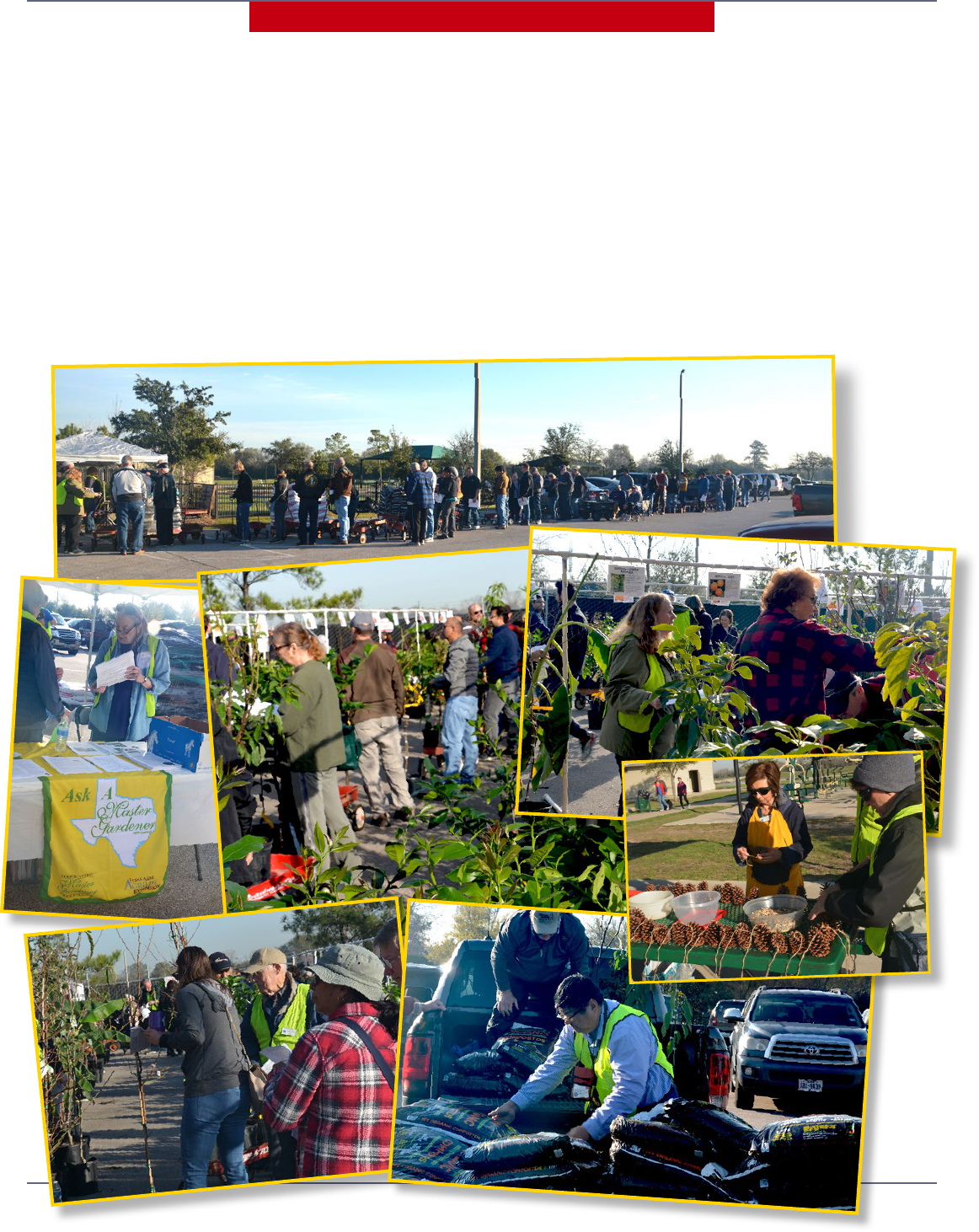
URBAN DIRT • FEBRUARY 2020
17
Scenes from the West Side Fruit Tree Sale!
by Carolyn Boyd, Master Gardener
An eager crowd of gardening enthusiasts descended on
Weekley Park on January 25th to peruse and purchase plants
from a wide variety of stock. We had 600+ citrus trees,
350+ non-citrus trees (including new varieties from the Texas
A&M University Stone Fruit Breeding Program), 80 avocado
trees, 120 g trees, almost 200 berry plants, plus Arabica coffee
and Zingiber ginger. And, customers could also purchase Mi-
croLife 6-2-4 and MicroLife Citrus & Fruit 6-2-4 Fertilizers, as
well as Super Rich Soils. The Growing With Plants And Nature
crew offered fun-lled gardening activities for kids.
A fun time was had by all!

18
URBAN DIRT • FEBRUARY 2020
C
ongratulations Jerri Grimland! Jerri worked in
the Chemical/Oil & Gas Industry for 35 years in
Accounting and Project Management for Projects and
Systems. Now, she is almost retired, and is working hard to
make it nal! She and her
husband have a happy,
fun-loving family with
ve children, 14 grand-
children, and one great
grandson. The family
events are action packed
with lots of love and
laughter.
Jerri started gardening
with her father when she
was small and learned so
Jerri Grimland
much from him, although her thumb will never be as green as
his. The Harris County Master Gardener program has turned
into a new love for her. Not only has she learned more about
gardening in general, but is able to give back and share what
she has learned. Currently an intern with the 2019 class, she has
settled into three programs where she feels able to contribute
based on her love of people and personality. Jerri is working
with Growing with Plants and Nature, Reach, and Ask a Master
Gardener at the moment, with plans to volunteer soon where she
can get her hands in the dirt! "I have so far to go," she says.
Thank you Jerri for all your hard work and help!
Is there a fellow MG you think should be recognized for their hard work and commitment?
If the answer is YES, you can submit their name for an MG of the Month nomination.
Submit your MG of the Month nominations to the Membership Committee by e-mailing the
information to [email protected] (West) or [email protected] (Genoa Friendship Gardens).
Nominate a Master Gardener of the Month
Karen Avery, Beatrice Brown, Brenda de Alba, Taffy Dineen,
Martha Gossett, Alexa Haass, Vicki Harbers, James Hobkirk,
Melissa Kaye, Marsha Long, Anne O'Neil, Lois Patterson, Mariana Pena,
Susan Visinsky-Bracken, Nora Wolff, Hallie Younker
Master Gardeners and Interns who celebrate a birthday during February include the following.
Wish them a HAPPY BIRTHDAY when you see them!
If your name is missing, please check that your online prole is complete.
MG of the Month - Jerri Grimland
by Karen Breneman, Master Gardener
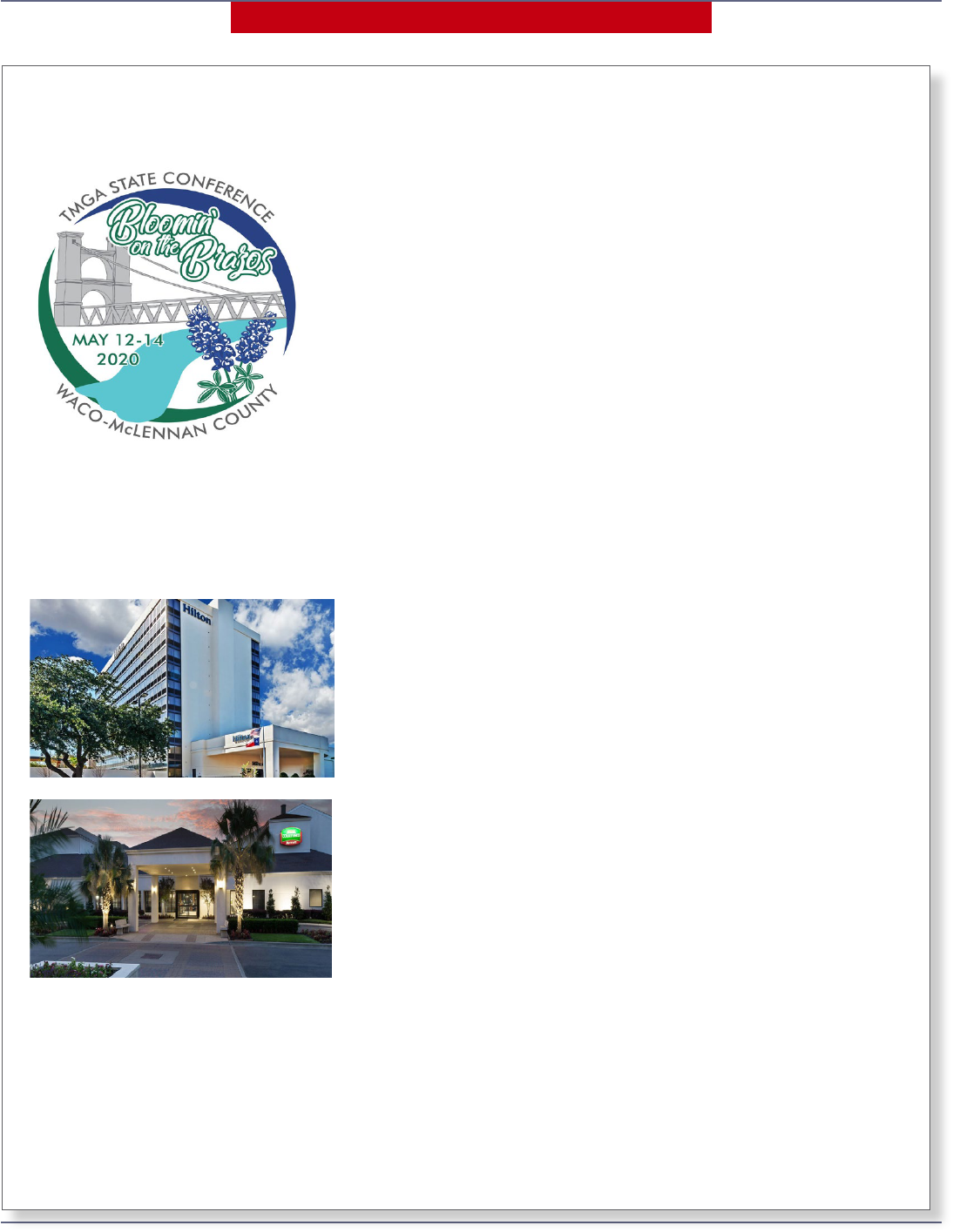
URBAN DIRT • FEBRUARY 2020
19
TMGA 2020 State Conference
LODGING: We have contracted with two great hotels for you! The host hotel, and its partner hotel
directly across the street, are now accepting reservations. Our agenda will have Leadership Training on
the afternoon of May 11th, with conference registration opening at 7:00 a.m. on May 12th. The conference
will close at 5:00 p.m. on the 14th. Our special hotel rates are valid for three days before, and three days
post-conference. Come, enjoy all that Waco has to offer!
Hilton Waco: This riverside hotel is connected by a covered
walkway to the Waco Convention Center - $149
Phone: 254-754-8484
https://www.hilton.com/en/hi/groups/personalized/
A/ACTWHHF-MGA20-20200510/index.jhtml
Courtyard Marriott: This newly remodeled hotel is
immediately adjacent to the Waco Convention Center - $145
Phone: 254-752-8686
https://www.marriott.com/event-reservations/reservation-link.
mi?id=1558020957260&key=GRP&app=resvlink
NOTE: If you wish to stay longer, both hotels will honor the above rates three days BEFORE and three
days AFTER our conference block, however, you must make these reservations by phoning the Reserva
-
tions Desk directly at the hotel using the phone numbers provided above.
The presentation from the August 3rd Director's Meeting, with an overview of the Event site,
Keynote Speakers, Tours, Workshops and Breakout Sessions, may be viewed here.
Proudly hosted by the McLennan County Master
Gardener Association in Waco, TX.
May 12-14, 2020 at the Waco Convention Center
Keep up to date on our conference
Facebook page.
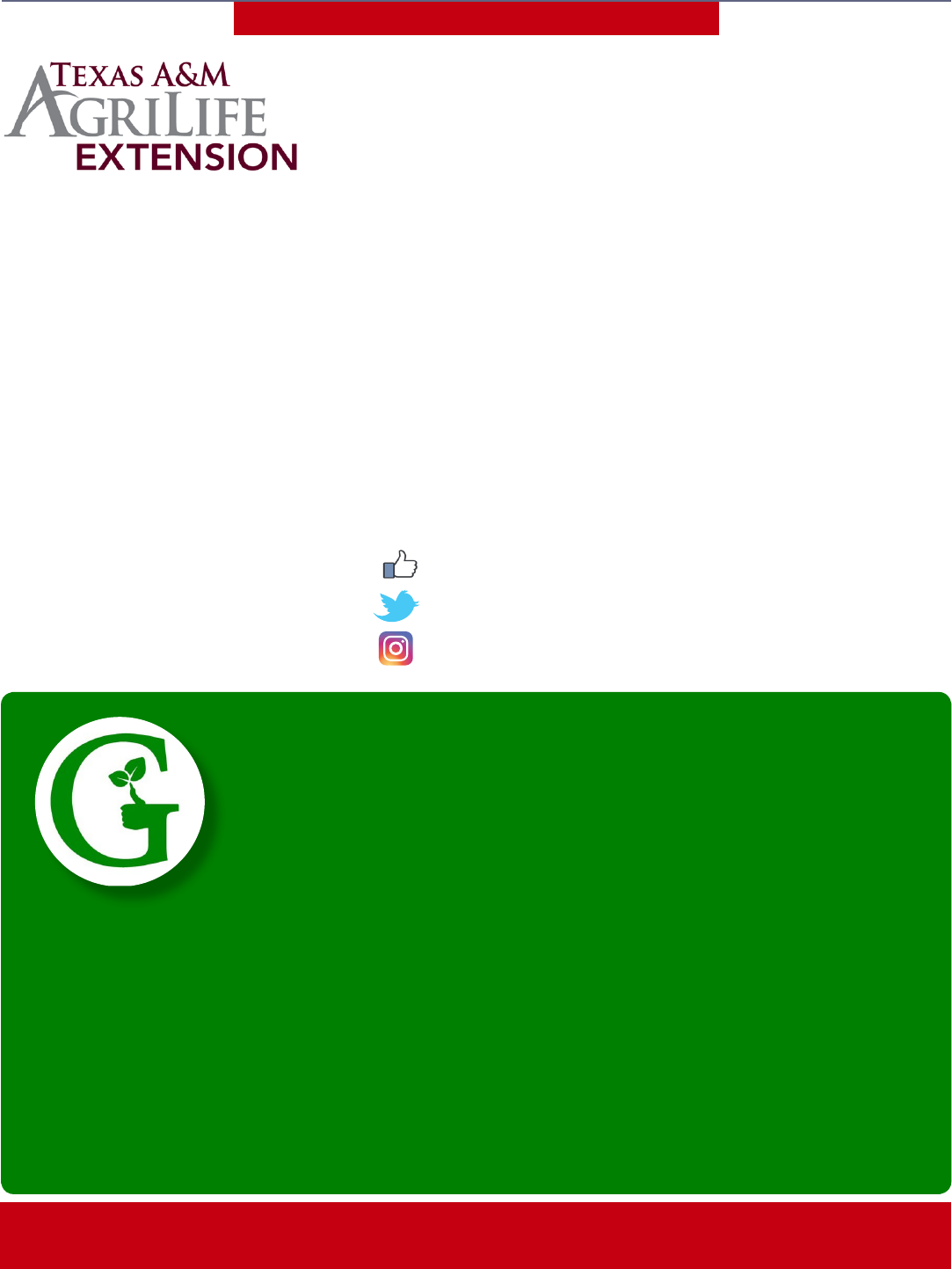
URBAN DIRT • FEBRUARY 2020
Texas a&M agriLife
e
xTension service
HousTon, Tx
713-274-0950
harris.agrilife.org/program-areas/hort/
hcmga.tamu.edu
Would you like to contribute to the Urban Dirt?
Send all questions and/or submissions to: [email protected]
Would you like to contribute to the Urban Dirt?
Send all questions and/or submissions to: [email protected]
www.facebook.com/HarrisCountyMasterGardeners
www.facebook.com/HarrisCountyHorticulture
https://twitter.com/pharrishort
https://www.instagram.com/harriscountymastergardeners
Follow Us On Facebook, Twitter & Instagram
The Harris County Master Gardeners as well as Texas A&M AgriLife Extension - Harris
County Horticulture are actively participating on Facebook, Twitter and Instagram offering
tips, lists, news and plant advice almost daily. The best part, instead of locating planting
guides or insect documents, and sale dates for individuals, you can add the HCMG site to
your account and easily share information with others. This is a denitely a timesaver for
these busy garden days and helps promote our organization.
February 20
Freeman Branch Library
6:30 – 8:30 p.m.
February 15
Maude Smith Marks Library
10:30 a.m. – 12:30 p.m
Spring Vegetable Gardening
Green Thumb Gardening Series
February 13
Barbara Bush Library
6:30 – 8:30 p.m.
February 18
Spring Branch Memorial Library
6:30 – 8:30 p.m.
